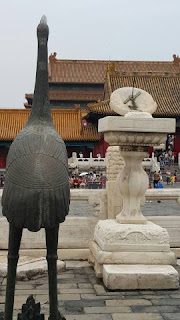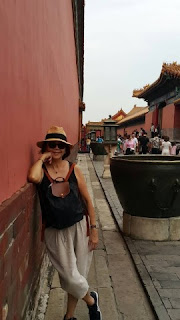Historical.
The second imperial capital of the Qing Dynasty, Chengde, is a two to three hours drive to the north east of Beijing. Being a favoured location of the Qing emperors as the weather is cooler here, they would make a journey of 7 days or so to the place for rest during summer.
Here, we were given a tour of two major spots, the Summer Palace and the Potala Palace.
In China, there are two summer palaces; one at Beijing and the other at Chengde; the latter being the extended version.
The Potala Palace
Legend or history has it that the Potala Palace was built by emperor Chieng Lung in commemoration of his 60th and his mother's 80th birthday. Tibetan Buddhism was the main influence then and Dalai Llamas had a strong impact here. The belief has it that one has more than a death and each death is hoped to be the stepping stone to a better next life. So, monks and followers strife to be at their best in a value system measured by good works. So, the spiritual realm was set .
At Chengde, we had another local guide and it was difficult to follow her accent. The glaring, hot afternoon sun did not help. On top of that roof, the 7 gigantic earthenware must have held a story. I did not get it. So we just look at the beautiful work. There are two elephant sculptures on both sides of the entrance; one a male and the other a female. You know the sex by the articles they hold; one a baby and the other a ball. So, the sacred animals must be the guards to the gate.
As you venture further in, you will notice that the palace consists of structures meant for mass meditation exercise, physical workouts and perhaps education. The drills are part and parcel of the faith. The extensive built-up connote massive gatherings for various events. Apart from that, it is just another piece of architecture which was so much a part of prom and celebration.
The panoramic view was breath-taking and far reaching. The vast country truly has acres of space that can accommodate numberless. A nation with thick history and populace.
The Summer Palace
Much has been talked about the palace. For me, it is a first interest and I could roughly guess what the components of the place would be; the public office, library, performance grounds, chambers and the like. A lot of protocol and dos and don'ts. The imperial and resplendent were not to be despised for it would have meant death.
Casually, I told Lily that the Chinese population itself would have been sufficient for tourism in China. Every nook and corner was not spared of local tourists. Truly, they are the bigger support today; I am convinced.
The characters must be connoting a get away locale for the royal family for rest and recuperation.
The floor tiles stay original and good. It is refreshing to touch old things and knowing history had walked along with them. All past happenings at this very site.
The Qing emperors officiate hearings and appeals here.
Yellow is royal colour. Anyone else clothed in this colour will be executed; Lily stated.
Stately ornaments may have been stolen or destroyed in the past.
Cedar. Solid and steadfast. No sign of aging.
It is this wood family that has been transported by the frozen rivers from Yunnan to the north. Apparently cedar is fragrant and keeps insecticides and pests away.
During the cultural revolution, some of the pillars may have been destroyed but are faithfully patched back.
The Library.
So much knowledge and learning. Yet so many mistakes.
Lily said emperor Kangxi was a good emperor. Nation prospered under his reign.
Read.
The most powerful lady behind the puppet emperor. Apparently when her husband, the emperor passed away, the regent was only a minor. So she ruled the nation behind the yellow curtain for a good 48 years before she died in her 70s. We were told too that the lineage under the emperor's line ended too. So, another relative from her sister's marriage took over the seat in the person of Pui Yi, the last emperor of China.
We were told many times to notice the colour of her hair.
No gray hair.
Reason?
She used a special comb.
The cedar comb.
Or Manchu origin, the Chengde guide told us to use the cedar comb daily and we will no more have gray hair. So some in the group bought at a discounted price of 100 yuan. Later we felt upset as another vendor in another part of the premise sold at 68 yuan.
The chamber for relaxation, dance and music.
Emperors work hard, play hard too with songs and concubines along.
No emperor has passed on without concubines ; even more true when the official queen has no heir to the throne. So much rivalry and revelry too.
This block of stone is stairway to the upper building. imaginative.
This is the entrance to another part of the summer residence; the garden.
Notice that step that divides the in and out of the entrance.
Many versions to the need for it; it wards of evil and everything weak and bad will be dispelled after crossing it.
When I asked further more, the guide gave up and said maybe it was also built to prevent flood waters from going into the house. What ?
The Summer Garden.
The grounds are huge and widespread. It was impossible to walk around it. Perhaps it is possible to go around a small patch. So buggies took us around from site to site. Sites which the guide had stories to relate.
Walking around made easy by well-laid steps. Much has been spent on the landscape.
Chinese nationals were on a break for the dragon boat cum dumpling festival.
Vehicles were not on the road but people were everywhere in the park.
The man made lake was large enough for boating activities , fishing and lotus planting.
Could not help but stole a shot here.
Beautiful and hot.
We were driven to this pavilion to observe how the shape of the roof changes from different angles.
We mocked at the silly idea. It was science in place. Nothing magical or mystical.
This was worst. On the left we were told to look at the 'image' of the moon's reflection on the pond. Next we were brought into a cave next to the pond and notice that crescent like hole? O how did we get into this story? Unnecessary.
The last site. The tower of blessings for the locals.
The final trick.
The hot spring which is a true reflection of science.
Water is warm because of the hot spring below it.
That ends our visit to Chengde.
Good day except for the heat.





























































